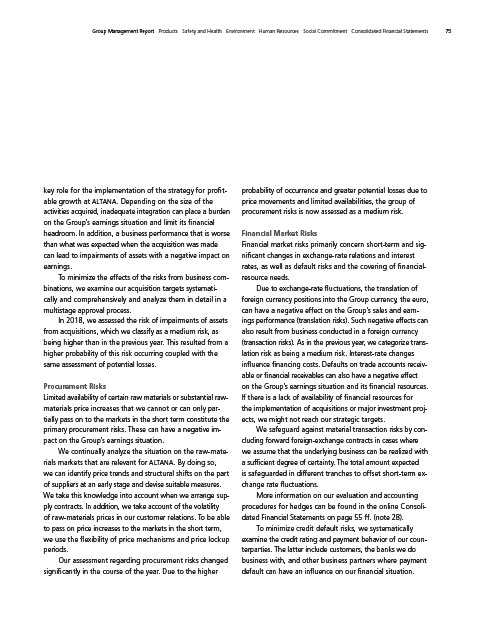
Group Management Report Products Safety and Health Environment Human Resources Social Commitment Consolidated Financial Statements 75
probability of occurrence and greater potential losses due to
price movements and limited availabilities, the group of
procurement risks is now assessed as a medium risk.
Financial Market Risks
Financial market risks primarily concern short-term and significant
changes in exchange-rate relations and interest
rates, as well as default risks and the covering of financial-
resource needs.
Due to exchange-rate fluctuations, the translation of
foreign currency positions into the Group currency, the euro,
can have a negative effect on the Group’s sales and earnings
performance (translation risks). Such negative effects can
also result from business conducted in a foreign currency
(transaction risks). As in the previous year, we categorize translation
risk as being a medium risk. Interest-rate changes
influence financing costs. Defaults on trade accounts receivable
or financial receivables can also have a negative effect
on the Group’s earnings situation and its financial resources.
If there is a lack of availability of financial resources for
the implementation of acquisitions or major investment projects,
we might not reach our strategic targets.
We safeguard against material transaction risks by concluding
forward foreign-exchange contracts in cases where
we assume that the underlying business can be realized with
a sufficient degree of certainty. The total amount expected
is safeguarded in different tranches to offset short-term exchange
rate fluctuations.
More information on our evaluation and accounting
procedures for hedges can be found in the online Consolidated
Financial Statements on page 55 ff. (note 28).
To minimize credit default risks, we systematically
examine the credit rating and payment behavior of our counterparties.
The latter include customers, the banks we do
business with, and other business partners where payment
default can have an influence on our financial situation.
key role for the implementation of the strategy for profitable
growth at ALTANA. Depending on the size of the
activities acquired, inadequate integration can place a burden
on the Group’s earnings situation and limit its financial
headroom. In addition, a business performance that is worse
than what was expected when the acquisition was made
can lead to impairments of assets with a negative impact on
earnings.
To minimize the effects of the risks from business combinations,
we examine our acquisition targets systematically
and comprehensively and analyze them in detail in a
multistage approval process.
In 2018, we assessed the risk of impairments of assets
from acquisitions, which we classify as a medium risk, as
being higher than in the previous year. This resulted from a
higher probability of this risk occurring coupled with the
same assessment of potential losses.
Procurement Risks
Limited availability of certain raw materials or substantial raw-
materials price increases that we cannot or can only par-
tially pass on to the markets in the short term constitute the
primary procurement risks. These can have a negative impact
on the Group’s earnings situation.
We continually analyze the situation on the raw-materials
markets that are relevant for ALTANA. By doing so,
we can identify price trends and structural shifts on the part
of suppliers at an early stage and devise suitable measures.
We take this knowledge into account when we arrange supply
contracts. In addition, we take account of the volatility
of raw-materials prices in our customer relations. To be able
to pass on price increases to the markets in the short term,
we use the flexibility of price mechanisms and price lockup
periods.
Our assessment regarding procurement risks changed
significantly in the course of the year. Due to the higher